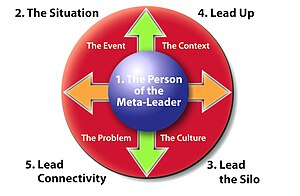 Image via Wikipedia
Image via WikipediaBecause of believe in punishment and reward, transactional leadership is now being applied to many companies and business who wish to see increased competition among employees, associates, and stakeholders. Often, transactional leaders expect a high degree of performance and perfection followed by giving out incentives as encouragement for enhanced performance. This kind of leadership creates competition among workers who compete for reward. According to Hickman (1998), the role of transactional leadership begins when contact is made with another person with the sole aim of making important exchanges. I am assuming many of you may have seen signs that read “employee of the month” hanging from the walls of many corporate offices and companies. Likewise, there seem to be proliferation of parking spots reserved exclusively for employees who perform well in their duties.
Situational leadership holds that managers must apply various leadership styles depending on the setting. Developed by behavioral scientist Paul Hersey and Ken Blanchard, situational leadership is a leadership style that works across cultural, linguistic, and geographical barriers. This leadership style focuses on how to retain star workers, reduce absenteeism, track employee performances, and above all improve job satisfaction. The model for level II situational leadership is about delegating, supporting, coaching, and directing. However, people who show high commitment, high competence should be left to do their jobs independently. Often, situational leadership is tied to task behavior, which is the amount of time, and guidance the leader provides to the follower and relationship behavior which is the amount of social and emotional support rendered (Yukl, 2006). Because people behave differently, this type of leadership works well with people of different cultures.
References
Burke, W. W. (2011). Organization change: Theory and practice (3rd ed.). Thousand Oaks, CA: SAGE Publications.
Robinson, H. G. (2010). Leading organizations: Perspectives for a new era (2nd ed.). Thousand Oaks, CA: SAGE Publications.
Yukl, G. (2006). Leadership in Organizations (6th ed.) Upper Saddle River, NJ: Pearson
Prentice Hall.


No comments:
Post a Comment